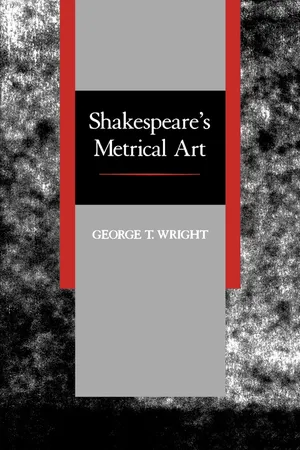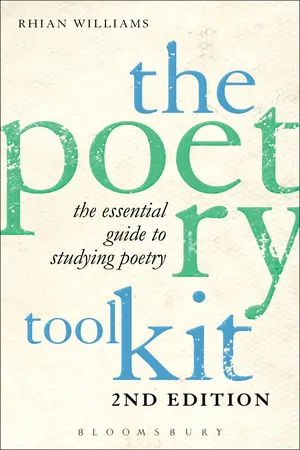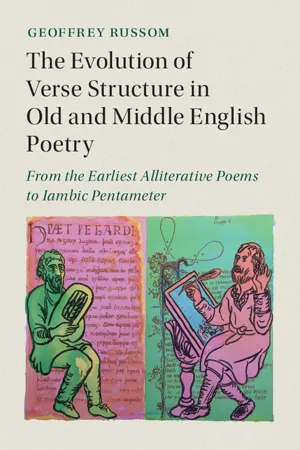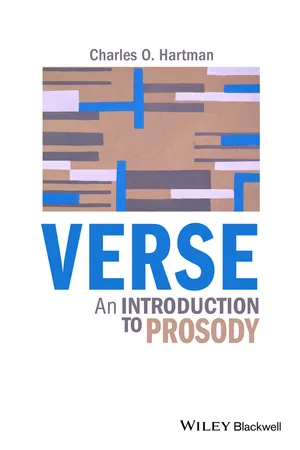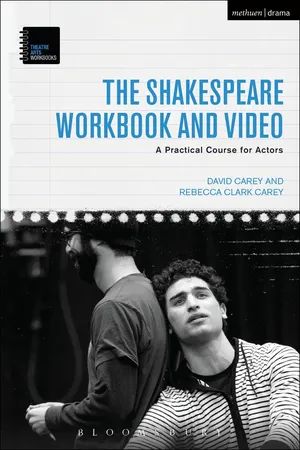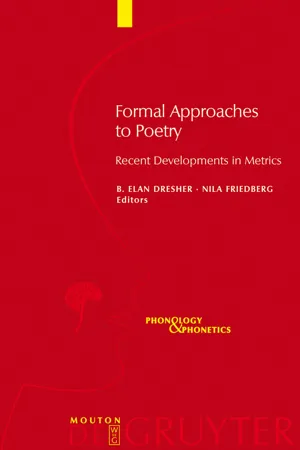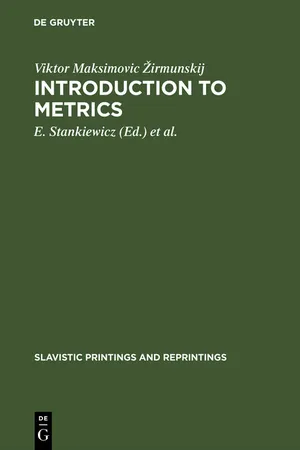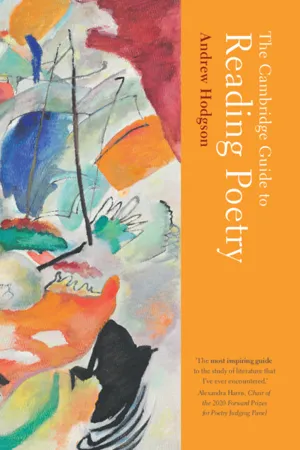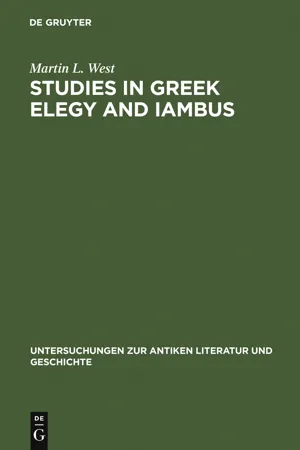Literature
Iamb
An iamb is a metrical foot in poetry consisting of two syllables, with the first syllable being unstressed and the second syllable stressed. It is a common metrical pattern in English poetry and is often used to create a natural and flowing rhythm in verse. The iamb is also known for its use in iambic pentameter, a popular poetic meter.
Written by Perlego with AI-assistance
12 Key excerpts on "Iamb"
- eBook - PDF
- George T. Wright(Author)
- 1988(Publication Date)
- University of California Press(Publisher)
1 I Shakespeare's Metrical Art Patterns we find in poetry always derive from patterns we discern or intuit in the world around us. 2 The arrangement of words and phrases in poetic lines reflects our custom of speaking, and of hearing each other speak, in a succession of rhythmic units; if the lines are metrical, if they make patterns out of series of lightly or strongly stressed syllables, they reflect the fact that when we speak we speak a succession of syllables with greater and lesser degrees of stress. If verse is Iambic, that means that it assumes as a fundamental feature of our speech the frequent—and some-times regular and rhythmic—alternation of unstressed and stressed syl-lables, and that it mirrors our occasional tendency to use several of those two kinds of syllables in that order—a climactic order perhaps, a rising rhythm (as it is often called), in which the movement is repeatedly (and even noticeably) from the less prominent syllable to the more prominent. Within the line we will usually be more aware of a quick succession of syllables with contrasting degrees of stress than of an insistent series of Iambs; it is easier to notice the alternation than to say whether at any point the rhythm is Iambic or trochaic. The first foot in Iambic verse, too, is frequently reversed, so that we start the line with a stressed syllable. The last foot, however, is rarely reversed, and the pattern we come to know as we keep listening to Iambic meter is one that moves inexorably, through several different modes of passage, to a final confirmation of Iambicity. On the other hand, poems that use many feminine endings tend to undermine this feature of Iambic verse and may have some expressive reason for do-ing so. - Mick Short(Author)
- 2018(Publication Date)
- Routledge(Publisher)
Now let us restrict our discussion for a moment to lines of poetry with Iambic ·('di dum') feet. Normally, Iambic lines will consist of more than one Iamb, and poets can choose how 132 Exploring the language of poems, plays and prose many Iambs to have as the basic line-template for particular poems. One particular form has dominated English poetry since the fifteenth-century, however, namely a line with five Iambs, as in the following example: Example 2 X I X I X I X I X I Then tooke the angrie witch her golden cup X I X I X I X IX I Which still she bore, replete with magick artes; (Edmund Spenser, The Faerie Queene, I, viii, 14) This kind of line is found throughout the verse of Shakespeare, Milton and Wordsworth, for example, and is called Iambic pentameter (literally 'Iambic five metre'). We might call the Iambic pentameter line the metrical norm for English poetry from the fifteenth-century onwards. Other possibilities can, of course, be found: 1. Manometer 2. Dimeter 3. Trimeter 4. Tetrameter 5. Pentameter 6. Hexameter one foot line two feet lines three feet lines four feet lines five feet lines six feet lines These 'number of feet' combinations can in principle involve any kind of foot as the basic unit, and various stanza forms can have patterns involving differing numbers of feet from line to line (for example, Keats's 'Song', which we analysed in 2.2. 7, has tetrameters in the first and third lines of each verse and trimeters in the second and fourth lines). But it is the Iamb in units of five which is the dominant English verse form. Exercise 1 (a) Re-examine Keats's 'Song' in 2.2.7. What is the rhythmical effect created by having a 'missing foot' in the second and fourth lines? (b) Below are a series of extracts from poems. Work out, for each example, what the basic foot unit is and how many feet there are to the line.- eBook - PDF
- Rhian Williams(Author)
- 2013(Publication Date)
- Bloomsbury Academic(Publisher)
Each foot is an Iamb (described below): the lines can be described as Iambic pentameters . However, although this poem appears to be very regular and even conserv-ative by sticking to the Iambic pentameter line, we see that commas actually introduce feminine caesuras (pauses after an unstressed syllable) into both lines’ central foot. So there is something idiosyncratic here, glimpsed within the The Poetry Toolkit 148 apparent calm of the poem. Just as the poem is interested in the visual sense (it describes a person gazing at a scene), so these little pauses are revealed when we visualize the feet on the page. The power that the natural scene has on the poet is even suggested by these tiny pauses, since they threaten to break the Iambic feet: the scene is so impressive the poet almost forgets his metrical skill. Note also how foot-divisions do not always coincide with word-endings: words can be split between feet as the metre rather than the words carries sway. In formal verse the number and type of feet per line is uniform (so the line length, the syllable count and the position of the stress in each foot is fixed), and the effect of bringing a series of identical feet together will be considered below. However, even in the most regular verse forms, some alterations occur, in the following ways: � l substitution : when one of the usual feet in a line is substituted with one that has a different stress pattern � l inversion : a type of substitution where the irregular foot reverses the stress pattern seen in the others � l outride : a foot containing extra unstressed syllables � l catalectic line: a line in which one (or more) unstressed syllable is missing; usually this is the final syllable, allowing the line to end on a stress � l hypercatalectic line: a line that has an extra unstressed syllable � l acephalous (from the Greek, ‘headless’) line: when the unstressed syllable in the first foot is missing. - eBook - PDF
The Evolution of Verse Structure in Old and Middle English Poetry
From the Earliest Alliterative Poems to Iambic Pentameter
- Geoffrey Russom(Author)
- 2017(Publication Date)
- Cambridge University Press(Publisher)
This is now usually non-syllabic [d], as in failed, or [t], as in stopped, but survives as syllabic to break up an unpronounceable [td] or [dd], as in boasted and loaded. Iambic pentameter employed a single line pattern composed of five identical feet. In contrast to alliterative verse types, which alternated unpredictably, the Iambic pattern could be apprehended even when simplex words crossed the foot boundary. Words that remained trochaic in Modern 259 English were no longer favored in the new form but the mismatches they created were manageable (section 1.17). What the new meter showcased were prestigious Iambic borrowings from French and Latin, words like replý and obscúre. The Iambic foot also provided an ideal site for the native Iambic phrases that proliferated as inflectional endings were replaced by function words such as articles, auxiliary verbs, and prepositions. Consider Beowulf 1507a, hrínga / þéngel, a highly valued realization of type A1 with two trochaic words. This translates as the lórd / of ríngs, with two Iambic word groups. Though abstracted from borrowed words with the most common French pattern, the Iamb was suitable for colloquial English as well. Iambic meter was a viable compromise between the native base language and imported words that achieved high frequency in literary English. 5 The shift from SOV to SVO broke the link between traditional alliterative patterns and optimal patterns of stress within phrases and sentences. The typical Iambic pentameter line was realized as an SVO sentence or clause with the most prominent phrasal stress on the last word – the most suitable location for a sound echo in Modern English. Since alliterative meter requires word stress in a fixed location (section 2.6), alliteration became less and less suitable as English borrowed words with non-initial stress. The radically anglicized forms required for alliterative meter must have seemed odd or rustic to sophisticated Londoners in Chaucer’s milieu. - eBook - ePub
Meter in English
A Critical Engagement
- David Baker(Author)
- 1997(Publication Date)
- University of Arkansas Press(Publisher)
In Shakespeare’s sonnet, as in other instances, the double-Iamb at the end of the line creates a slight hesitation which levels out into a small but important musical delay. The dissonance of such a measure can acquire an unusual and definite emotional colour which is effective in making a mood which is just perceptibly off the note. In other words the double-Iamb is an attention-seeking unit of scansion.Take, for instance, this stanza from “Wessex Heights” by Thomas Hardy. The poem was written in 1896. It has the off-key brio of some of Hardy’s defiantly local poems. Nevertheless, despite the long balladeering line, despite the attack and jingle of the stresses, there is something open-ended and hesitant about the ending of the stanza, an effect in which the double-Iamb plays a decisive part:There are some heights in Wessex, shaped as if by a kindly hand, For thinking, dreaming, dying on, and at crises when I stand, Say, on Ingpen Beacon eastward, or on Wylls-Neck westwardly, I seem where I was before my birth, and after death may be. (8) “Anapestic, trochaic, and dactylic meters do not exist in English.”It has been one of the most intense debates of the century, as to whether the normative base of meter is Iambic. When Eliot qualified modernism as “not a revolt against form but against dead form,” I have no doubt that this was part of what was in his mind. Arnold Stein in his essay on George Herbert’s prosody speaks of the momentum and emphasis of poetry in these terms: “A movement forward that did not remember as it paused could neither repeat nor vary; to this extent every means of ordering movement forward depends on listening backward.”The forward movement of poetry in English is largely organized according to Iambic principles. This seems clear although it is by no means uncontentious. Therefore it seems sensible, as Robert Wallace suggests, to take the Iamb as the defining presence in the metrical structure of English poetry, and to consider trochaic and anapestic and dactylic variations as just that: variants but not meters. If there is to be a science of meter at all, if there is to be a codified series of propositions which continues to define and hand on the practice of meter, then it is essential that it clarifies its tenets and does not simply clutter them with possibilities and alternates. The anapestic and dactylic can certainly be submeters. But the metrical base remains Iambic. - eBook - ePub
Verse
An Introduction to Prosody
- Charles O. Hartman(Author)
- 2015(Publication Date)
- Wiley-Blackwell(Publisher)
Anapests, with just one stress in three syllables, go the other way, toward relaxation. Furthermore, a series of anapests in a row produce a “runaway horse” effect – sentences galloping recklessly over whatever they try to communicate – that tends to drown out any subtler music. Poets are wary of these “triple threats to duple rhythm,” as the critic Edward Weismiller has called them. (A duple rhythm is one based on a two-syllable foot like the Iamb.) If a line has a string of especially light stresses – “I do not at this point in time agree” – it can be all too easy to hear and scan as an anapestic tetrameter: x x / | x x / | x / | x / (?) I do not at this point in time agree (This is a made-up bad example; poets avoid this kind of uncertainty in meter.) The solution, when scanning a line, is to remember to hold the number of feet in the line constant. The Persistence of Line Length If the poem begins in Iambic pentameter, expect every line to have five feet. (Remember that the double Iamb counts as two.) What the five feet are can vary, but not their number. It’s useful to think of this rule as absolute: when you’re scanning a poem in Iambic pentameter, always check to make sure every line has five feet, not four or six. These are easy mistakes to make. You’ll encounter two kinds of exceptions to this rule. First, when lines are collected into stanza forms (which we’ll discuss in Chapter 3), those repeated stanzas may systematically vary the number of feet in particular lines. The Spenserian stanza, for example, is eight Iambic pentameters followed by one Iambic hexameter. Keats’s “Ode to a Nightingale” is mostly in Iambic pentameter, but he shortens the eighth line of each stanza to an Iambic trimeter. Second, in the period when Iambic pentameter dominated English poetry most thoroughly – roughly, the “long Eighteenth Century” – an accepted source of variety was to introduce an occasional hexameter - eBook - PDF
The Shakespeare Workbook and Video
A Practical Course for Actors
- David Carey, Rebecca Clark Carey(Authors)
- 2015(Publication Date)
- Methuen Drama(Publisher)
But what are the characteristics of blank verse that Shakespeare inherited? Blank verse was composed of unrhymed lines in the meter known as Iambic pentameter . This term, which has come down to us from the poetry of classical Greece, tells us that the metrical structure of each line is based on a rhythmic unit (or foot ) composed of a syllable of weak stress followed by a syllable of stronger stress; for example, the word ‘composed’ would make such a rhythmic unit because the first syllable (com) is relatively weak or unstressed, while the second syllable (posed) is more strongly stressed This type of foot is called an Iamb (from the use of this rhythm in Greek satirical poems called Iambi ) and it occurs five times ( penta , from the Greek for ‘five’) in a line of Iambic pentameter. RHYTHM AND METER 113 Take a look at this line from Marlowe’s Tamburlaine the Great, Part Two (Act 3 Scene 2): I’ll have you learn to sleep upon the ground Speak it out loud and notice how the writer has arranged it into a pattern of five Iambic feet (the vertical line is used to show the foot divisions): I’ll have| you learn| to sleep| u-pon| the ground We call this a regular Iambic pentameter line, because the pattern of a relatively weak syllable followed by a more strongly stressed syllable is kept constant over the five feet. But notice that not all the stressed syllables have the same weight: if you say the line quite naturally, it’s likely that learn , sleep and ground have more stress than have and -pon . Similarly, the unstressed syllables are not all equally weak: it’s likely that I’ll and you are more strongly stressed than to , u-, and the . This is because words with more semantic content (or significance) normally take more stress in English than words with little or no semantic content. So, the Iambic pattern exists in the relative strength of the syllables in each foot rather than across the whole line. - eBook - PDF
Formal Approaches to Poetry
Recent Developments in Metrics
- B. Elan Dresher, Nila Friedberg, B. Elan Dresher, Nila Friedberg(Authors)
- 2008(Publication Date)
- De Gruyter Mouton(Publisher)
Now we may turn to Frost’s “deviating” lines and see whether some of them are still metrical, or anomalous even for this poet. The problem of metricality is more complicated for English Iambs than for their European counterparts, such as German or Russian. First, the most common Iambic meter in English is not tetrameter (as in Russian) but pentameter, with its more numerous accentual line variations. Secondly, the creators of the Eng-lish Iamb, rst Chaucer, and later Wyatt, learned from French and Italian syllabic poetry and incorporated some of its features, as in Wyatt’s earlier translations of Petrarch’s sonnets. Finally, words in English are short, and there are many stressed monosyllables that often fall on W syllabic positions. Consequently, the English Iamb allows a wide range of licenses. 2. Theories of Iambic meter American scholars have been discussing for forty years now how to de ne a “well-formed” Iambic pentameter line. The debate was started by Halle and Keyser (1966, 1971); several other scholars contributed to the discussion, for example, Magnuson and Ryder (1971), and Kiparsky (1975, 1977). Halle and Keyser assumed that at the basis of Iambic poetry lies an abstract model, What is “metricality”? English Iambic pentameter 57 a sequence of alternating syllabic positions W S W S W S..., and that actual lines are generated from the model according to a set of rules. (A similar ap-proach was outlined by Russian “formalists” during the rst quarter of the 20th century (Zhirmunsky 1925, Tomashevsky 1929, cf. Halle’s review of Zhirmunsky’s works in Halle 1968)). Lines that do not comply with the rules were called ill-formed. The formulation of the rules was modi ed several times to account for a wider range of actual lines. 2.1. Stress maxima The earliest theory disallowed “stress maxima” on W (Halle and Keyser 1966, 1971) making a good proportion of actual Iambic verse unmetrical. - eBook - PDF
Introduction to metrics
The theory of verse
- Viktor Maksimovic Žirmunskij, E. Stankiewicz, W. N. Vickery, C. F. Brown(Authors)
- 2016(Publication Date)
- De Gruyter Mouton(Publisher)
This will be treated in greater detail in Chap. III. 9. RHYTHM AND METER IN BINARY METERS The methodological principles expounded in Simvolizm, where they were related to the Iambic tetrameter, can be used as the basis for studying SYLLABO-TONIC VERSIFICATION 49 other meters of Russian poetry. In doing so, one discovers considerable difference between the rhythmical characteristics of the binary meters (two-syllable feet — Iambs and trochees) and those of the ternary meters (three-syllable feet — dactyls, amphibrachs, anapests). In all binary meters the rhythmic variations consist, in most cases, of weakening the stress on certain metrically strong syllables (omission of metrical accents). The last stress, however, which marks the line boundary and is itself marked by rhyme, always remains intact. The stress is most frequently dropped on the next to last foot, the penultimate; other stresses are more rarely discarded, their omission depending on the character of the meter itself or on the rhythmical style of a given poet. In the Iambic trimeter, where the stress on the sixth syllable remains intact, it is the stress on the fourth syllable which is most often omitted. A line of six syllables bearing stresses on the second and sixth is the most usual variation of the Iambic trimeter. It is extremely rare to encounter an omitted stress on the second syllable. 7 Consider Puskin's epistle to his sister Κ sestre: Ty xóceS', drúg bescénnyj, Ctob já, poét mladój, Besédoval s tobój, I s líroju zabvénnoj, 5. Mectámi okrylënnoj, Ostávil monastyr' I kráj uedinënnyj, Gde nepreryvnyj mir Vo mráke opustílsja, 10. I ν pústyni gluxój Bezmólvno vocarñsja S ugrjúmoj tiáinój !... Lines 1 and 2 have three metrical stresses, line 8 is the rare example of an omitted stress on the second syllable, and the other nine verses are of the predominating type (with the stress dropped on the fourth syllable). - eBook - PDF
- Peter Robinson(Author)
- 2018(Publication Date)
- Cambridge University Press(Publisher)
The rhythm of a poem is an experience of the patterned sound it makes when read aloud; any identifiable pattern, regularised in hinted at binary alternations of stress, is its meter. As already noted, the meter is an abstract template that can, with varying degrees of plausibility, depending on the complexity of the cases, be identified by analyzing a poem’s lines and phrases. In all but the simplest of jingles, the meter and rhythm, template and performance, are by no means the same. This is because there are more Richard Wollheim draws a distinction between knowing a language and having an artistic style in Painting as an Art (Princeton: Princeton University Press, ), . His distinction, if applied to poetry, is complicated by language speakers having prosodic style in their usage informed by knowledge of lullabies, chants and other folk poetry with what he calls ‘psycho-motor reality’. Seymour Chatman takes it as axiomatic ‘that meter is a species of rhythm’ in A Theory of Meter (The Hague: Mouton, ), . Though he does not confuse the terms, I prefer them separated for clarity of exposition. For an account of why the terms meter and rhythm can be contrasted and where the contrast is inherited from, see John Hollander’s account of the Greek metrikoi and rhythmikoi in Vision and Resonance: Two Senses of Poetic Form (New York: Oxford University Press, ), –. The Sound Sense of Poetry than two levels of stress in naturally pronounced English. Even in jingles the distinct characters of the individual syllables will give variety to the simplification of such sounds into the abstractly alternating ‘ti tum ’ of, in this instance, Iambic metrical feet. These feet are similarly abstract inter- pretations attributed to formed phrasings. Intuiting a meter may be necessary, but is by no means sufficient to hearing the poem. - eBook - PDF
- Andrew Hodgson(Author)
- 2021(Publication Date)
- Cambridge University Press(Publisher)
Sometimes the divisions between feet will fall between words, sometimes they will fall within them. The most common metrical feet take the following shapes (where / equates to an accented syllable, and x to a lighter, unaccented one): trochee: a foot in which the first syllable is more heavily stressed than the second (/ x) Iamb: a foot in which the second syllable is more heavily stressed than the first (x /) dactyl: a foot in which the first syllable is more heavily stressed than the last two (/ x x) anapaest: a foot in which the third syllable is more heavily stressed than the first two (x x /) How Can We Describe the Rhythms? 77 We should note straight away that any division of language into ‘stressed’ and ‘unstressed’ syllables is a simplification. In practice, the gradations of emphasis we might place on a syllable are almost infinite, and the leaps between the accented and unaccented syllables in a foot may be large or small: all that is required in a trochee is that emphasis falls from the first to the second syllable, and all that is required in an Iamb is that emphasis rises from the first to the second. The beats will fall at regular intervals along a line, but they might land with differing intensity. We will return to this point in due course. In addition to the above terms, you might also encounter the terms spondee (describing a foot of successive heavily stressed syllables of equal emphasis (/ /)) and pyrrhic foot (describing a foot of two successive lightly stressed syllables of equal emphasis (x x)). In practice, such occurrences are rare: it is seldom that one syllable in a foot doesn’t take slightly more emphasis than another, even if both seem very heavily or lightly stressed. - eBook - PDF
- Martin L. West(Author)
- 2011(Publication Date)
- De Gruyter(Publisher)
II Iambus The term 'ίαμβος is commonly used by the ancients in referring to a poem of a certain type. It was applied, most notably, to the trimeters and tetrameters of Archilochus; probably also to his epodes, since Callimachus' book of Ιαμβοι includes poems in epodic metre, and Horace refers to his own Epodes as Parii Iambi. 1 It was applied to Semonides' trimeters; to Solon's trimeters and tetrameters; to Hippo-nax's cholIambic trimeters and tetrameters, among which an occasional hexameter or half-hexameter could appear (frr. 23, 35); perhaps, again, to his epodes; to an epode of Anacreon (fr. Iamb. 5); and to trimeters and tetrameters of Hermippus which stood apart from his comedies. Outside the Ionian area, it appears as the description of compositions by Aristoxenus of Selinus, an early writer whose only fragment is anapaestic, and by Asopodorus of Phlius who wrote in prose, probably about the time of Alexander, since he alternated with the aulete Antigenidas in an anecdote (Ath. 631 f). It follows that the name ί'αμβος does not automatically imply a particular metre or metrical type. Iambic metre got its name from being particularly characteristic of ίαμβοι, not vice versa. 2 What then is the essence of Iambus ? Is it its notoriously abusive character ? Certain-ly ίαμβίζω and ίαμβοποιεΐν mean 'satirize', and Catullus calls bis lam-poons Iambi even though metrically they do not stand in the Greek Iambographic tradition (36. 5, 40. 2, 54. 6). Invective was clearly regarded as the outstanding feature of the genre. On the other hand, 'ίαμβος does not seem to be used simply to mean 'an invective'. Nor are those poems of Archilochus, Semonides and others that were collecti-vely known as Iambi to later writers uniformly of an invective nature.
Index pages curate the most relevant extracts from our library of academic textbooks. They’ve been created using an in-house natural language model (NLM), each adding context and meaning to key research topics.
